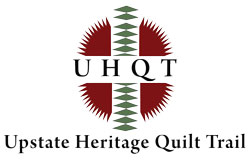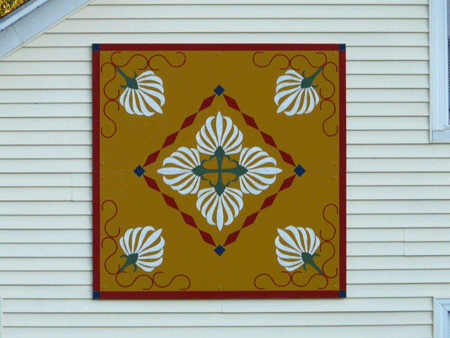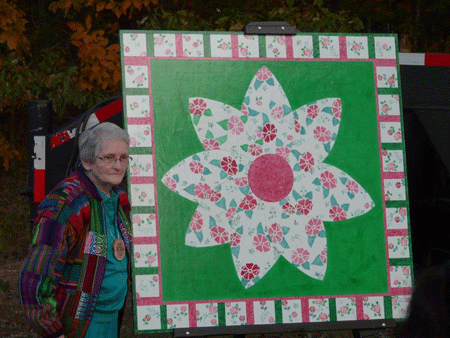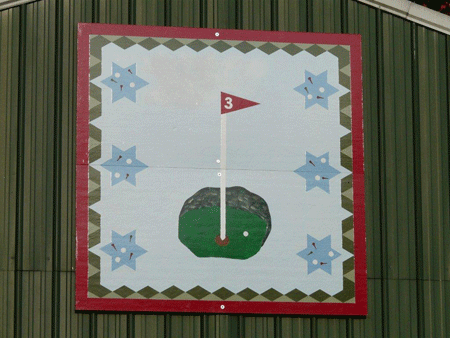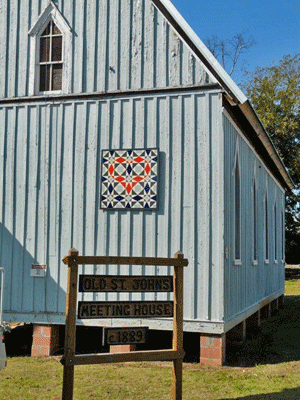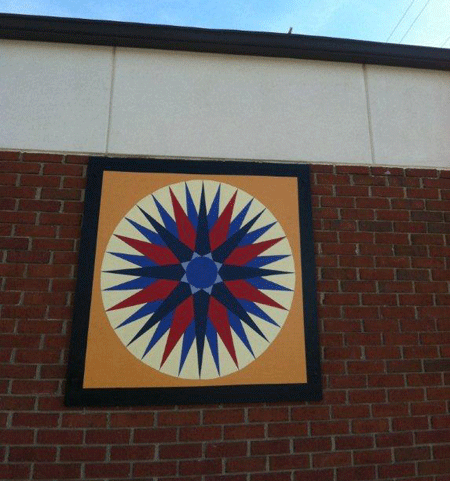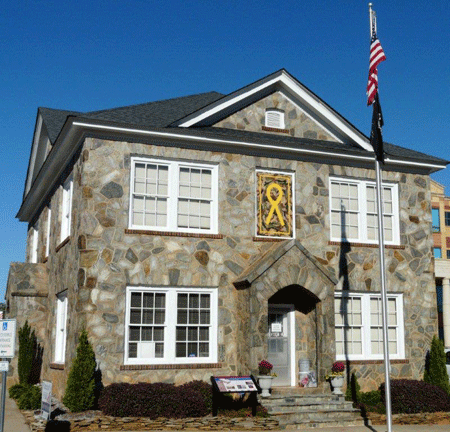The good folks behind the Upstate Heritage Quilt Trail has been very busy adding new quilt squares to buildings in the Upstate of South Carolina.
Here’s the info.
#65 The Cotton Boll Quilt
The history of the textile industry in Walhalla, SC, is the subject of the latest addition to the Upstate Heritage Quilt Trail. Mrs. Mary Lou Cushman of Walhalla has sponsored a quilt block called The Cotton Boll Quilt to honor her parents, Rachel Turner McGuffin and John Q. McGuffin, both of whom worked in the Walhalla textile mills. It is mounted on her home at 301 Jaynes Street in the Mill Village. The pattern was originally quilted by Dixie Haywood, noted teacher, quilter and writer of books about quilting. “This is a traditional Carolina block made in the late 19th century. It’s usually made on a white background with Flying Geese sashing, but I changed that part of the design with a yellow background to evoke a hot summer field. That’s why I call my version, ‘Hot Cotton!’”
During the late 1800s and throughout the 20th century, the textile industry played a significant role in shaping the lives of Walhalla residents and the culture of Upstate South Carolina. Walhalla had two main textile mills in operation. Both mills were located along Walhalla’s Blue Ridge Railroad line, one on the edge of town near West Union along Earle Street and the other in the heart of town on South John Street. These mills went by numerous names as company ownership changed frequently. The mill on the edge of town, which has since been torn down, was known primarily as the Kenneth Mill. The mill in the heart of town is known best as Chicopee Mill or Avondale Mill. It is no longer in operation and is currently for sale. Mill companies were very paternalistic and built company towns for employees to live in around the manufacturing facility. These “mill hills” had dozens of houses all built in the typical “salt box” style, company stores, post offices, and even schools. The mill hills were very closely knit communities and many formed baseball teams that played against each other recreationally. Work in the factories was reliable and many farming families from the surrounding mountain communities moved to Walhalla for work in the mills. Toward the end of the 20th century textile manufacturing slowed in Walhalla and the Upstate as work began being outsourced until all textile production stopped by the late 1990s.
One of Mrs. Cushman’s strongest memories is of living in the Mill Village, where her mother’s friends would gather in their home to work on a quilt. Her mother’s quilt frame, which normally hung suspended from the ceiling, was lowered to lap level. While the women gathered around the frame, little Mary Lou would hide out under the frame in her own secret, dark hide-away listening to all the Village gossip. Always in the background were the sounds of the textile mill. When her father came home, the cotton mill smell would be clinging to him.
The house where Mary Lou lives and where the quilt block is displayed is 100 years old and original to the Mill Village. She chose the cotton boll pattern to honor her parents, the other textile workers and the history of the textile industry in Oconee County. Walhalla was a thriving, bustling town, due to the textile mill and the men and women who worked tirelessly to produce quality American goods. In turn, the textile industry allowed many to care for their families and to improve the quality of life for all. It is her hope that when people see the cotton boll quilt block, they will be reminded of what was an important and vital part of the history of South Carolina.
Dixie Haywood has been quilting professionally since the early 1970′s, but made a quilt for her first child in 1955 – a “totally impractical small satin whole cloth with pink on one side and blue on the other. It became a ‘cozy’ for all three children and accompanied my daughter to college. It’s now in her family archives.”
Haywood says she is self-taught, having worked with fabric most of her life. Her mother had many talents – painting, needlework, lace making, while Dixie stuck with sewing and knitting. She loves quilting for the excitement of design, the satisfaction of mundane construction and the meditative quality of hand quilting. She’s written eight books, six with Jane Hall of Raleigh, NC, all of which explore and expand the technique of foundation piecing. “I’m in no-man’s (woman’s??) land between the traditional quilter and the art quilter, but I do innovative versions of tradition. I get a lot of comments about my use of color, and that’s the hardest part of it. Right now I’m rethinking a color group that just isn’t working – an old story….”
Haywood claims the ‘Blunder Technique’ powered her quilting career – “I just did what I was interested in and let the chips fall where they may.”
#63 Fenced in Dahlia Quilt
The Fair Play Presbyterian Church joined the Upstate Heritage Quilt Trail in October 2011 with the addition of a “Fenced in Dahlia” quilt block made by church member Ola Coombs, sponsored by the Mountain Lakes Region of the South Carolina National Heritage Corridor and the South Carolina National Heritage Corridor. Designs composed of a single flower with multiple petals are some of the most recognizable quilt patterns of the 20th century. Quiltmakers find numerous ways to combine colors and printed fabrics in ways that enhance the patchwork, including adding a patchwork “fence” as a border for this Dahlia pattern.
According to Mrs. Coombs, “My sewing life began over 75 years ago. I made my first quilt at the age of seven. Fabric, scissors, needles, thimbles and thread have always been a part of my life. My mother would invite friends who quilted like she did – she was known for her tiny stitches and high quality quilts. Flour sacks and sugar sacks were used to make bed linens and covers in our home. Mother would find 3 cents and use it to buy a package of dye to make the sacks a little more colorful. Red and blue dye cost 5 cents, so we had to settle for an ugly brown or green. I still have one of those early quilts and I treasure it.”
“My love for fabric, patterns and quilts has always been a part of me,” adds Coombs. “Natural colors remind me of God’s embroidered beauty, and the Dahlia is probably my favorite flower. The rich, velvety blend of color in the petals of the dahlia reminds me of today’s Batik fabric. My planning ideas went on a nature trip, and I designed the Fenced in Dahlia block for a queen-sized quilt.
Fair Play Presbyterian Church is celebrating its 108th year. Early in its history, a huge storm blew the church off its foundation. Within a very short time, members were out with horses and mules, lifting the building back on its feet and it’s been serving the community of Fair Play ever since. The Church is small but very involved in the community. There have been, and continue to be, many community outreach programs. Ola Coombs, Music Director, created an annual Christmas program for the Church and community which has drawn hundreds of visitors from every part of Oconee and Anderson counties while providing an evening that is entertaining but also uplifting and spiritual. This little Church continues to have a huge impact on the lives of people in the area. This block will have a temporary home at the entrance of the new nature trail and its permanent location will be on the activity shelter once completed. The church is located at 201 Fair Play Church Road in Fair Play, SC.
#63 Par 3 Quilt
The Blue Ridge Golf Center in Walhalla recently became a part of the Upstate Heritage Quilt Trail with the addition of a quilt block. Designed and sponsored by Jenny Grobusky, the quilt she calls “Par 3” is in honor of Mr. and Mrs. Joseph T. Grobusky who bought the land on Hwy. 28 in 1922. Mr. Grobusky was a farmer and carpenter by trade and served in the Spanish-American War in Cuba in 1898. The property was first used for farming wheat and cotton. Mrs. Grobusky used her skills as a seamstress to create many quilts to warm her large family. As Jennie tells it, “I don’t think that the Joseph Grobuskys knew anything but hard work on the farm, children and their religion. I only knew Mrs. Grobusky, who was a wonderful mother-in-law. She loved her children and grandchildren.”
Robert Grobusky, a grandson, who now owns the land, grew Christmas trees for many years before transforming the entire farm into a 10-hole par-3 golf course. Except for renovating a couple of rooms to accommodate the present day pro shop, the house remains much the same as it has been for the past 80 years. There are still pieces of furniture in the pro shop that were made by Joseph Grobusky. The original barn was torn down to make way for a driving range. The barn where the quilt block is mounted houses machinery for the golf course. The original quilt comes from a wall hanging created and quilted by Jennie Grobusky and hangs in the Pro Shop.
Blue Ridge Golf Center has been a source of enjoyment to golfers in Oconee County and the surrounding areas. It is also home to Blue Ridge Junior Golf, a learning program for the county’s 5th grade students.
Jenny Grobusky is well known in the Upstate for her needlework skills. She was a teacher of sewing, quilting and helping others learn these skills and was the first recipient of the Upstate Heritage Quilt Trail’s Quilter of the Year award in 2009.
#66 Storm at Sea Quilt
Old St. John’s Meeting House in Walhalla has received a quilt block and is now a part of the Upstate Heritage Quilt Trail. The church began serving parishioners of the Episcopal Church in 1889, having been constructed in the Rural Gothic architectural style by ‘master builder’ John Kaufmann. The founder and first president of the American Institute of Architects, Richard Upjohn, introduced Gothic Revival to the United States. His book, “Rural Architecture” (1852) provided patterns for countless buildings throughout the country. Deconsecrated in 1957, Jack Kelley moved the church at his own expense from Short Street to North Pine Street in 1982. The building was moved once again to 301 N. Catherine Street, near the Walhalla City Park, Kaufmann Square, in March 2009.
Sponsored through a grant given to Upstate Heritage Quit Trail, by The Mountain Lakes Region of the South Carolina National Heritage Corridor and the South Carolina National Heritage Corridor, the quilt pattern is called Storm at Sea and was originally quilted by Alberta Ramey Bowers (1926 – 2007), a native of Oconee County, for her oldest son, James. She made many quilts over the years as fundraisers for the Walhalla Civic Auditorium and the Meeting House. She had made quilts for each of her children and grandchildren, and became interested in the fate of the little church after it was vandalized at its previous location. Her husband and two sons placed hard mesh wire over the windows to prevent further damage. Her first quilt for the church was called Ties That Bind since it was made from a collection of men’s neckties. Mrs. Bowers was a trained nurse, the mother of three and a skilled seamstress. Quilting became her passion on her return to Walhalla.
#67 Mariner’s Compass Quilt
The Iva Quilting Ladies Group has added their second quilt to the Upstate Heritage Quilt Trail. Called a Mariners Compass, it is located on the Peoples Bank located on the corner of Green Street and Highway 81 in Iva, SC. It too is on the SC Heritage Corridor and is a pattern that was used by many of the older ladies in the quilting club of years gone by. They met faithfully each week to quilt in the old Iva High School Cafeteria. Shawn McGee, CFO of the Peoples Bank, told us that one of those ladies was a member of his church as well as his Sunday school teacher. Another was his family’s “nanny” babysitter/housekeeper. “This is an excellent memorial to them, in appreciation for their faithful work.” Students of Sara Jordan, art teacher at Starr-Iva Middle School, assisted in the painting of this quilt block.
The complexity of the Mariners Compass pattern, appealed to skilled quiltmakers of the mid-1800′s. The radiating designs appeared in many variations under such names as Compass Rose, Chips and Whetstones, Sunburst and Sunflower. These patterns require the quilter to measure, cut and sew accurately, so that the points are sharp and all the pieces lie flat without bunching or rippling. Many girls studied geometry in school, learning the use of the drafting compass, an ancient tool for measuring and reproducing arcs. Compass patterns typically contain an even number of points, usually 12, 16 or 32, but some women showed off their skill by carefully crafting blocks with 11 or 13 points.
#68 Yellow Ribbon Quilt
Patriots’ Hall: Oconee Veterans Museum in Walhalla has joined the Upstate Heritage Quilt Trail. Sponsored by the Patriots’ Hall Association, the quilt pattern is a ‘Save Our Troops Ribbon” and called Yellow Ribbon. Marilyn Delay of Edwardsville, IL, originally quilted this pattern.
The origin of the yellow ribbon most likely came from our Puritan heritage. The English Puritan Army wore yellow sashes onto the battlefield. Yellow is the official color of the Armor Branch of the United States Army, was usually worn by the Cavalry, and was associated with the yellow neckerchief attributed to various artists in Hollywood films. The symbol was first used as a popular military marching song in 1917 – “Round Her Neck She Wears a Yeller Ribbon”. These lyrics were somewhat altered in 1949 to “She Wore A Yellow Ribbon”.
Currently, we see yellow ribbons around trees signifying the residents of a home are waiting for the return of a loved one. This idea originated from the song “Tie a Yellow Ribbon ‘Round the Old Oak Tree”. During the Iran hostage crisis, the yellow ribbon was used as a symbol of support for the hostages held at the United States Embassy in Tehran. It symbolized the resolve of the American people to win the hostages’ safe release. There was renewed popularity of the yellow ribbon in the United States during the Gulf War in the 1990s, along with the slogan, “Support Our Troops.” It appeared again during the 2003 invasion of Iraq. The yellow ribbon most prominently appears in magnetic form displayed on the outside of automobiles or as a small pin worn on the lapel.
Delay doesn’t remember a time she did not have a scrap of material in her hands. Her mother, grandmother and paternal aunts sewed, quilted, knitted, and crocheted. “There were quilt frames, sewing machines and needles of all kinds around the house. I finished my first quilt on my own shortly before my daughter was born 40 years ago. We still have the quilt and all three granddaughters and one grandson have used it.”
Delay’s philosophy about quilts? “I really feel quilts should be used daily. Even Gracie, our dog, has her own quilts. Many times, the granddaughters will choose which quilt to use for their overnight stays. I love pinwheels and stars, and I love to work with the fabrics from the 1930′s.”
Delay earned a first place ribbon at the Madison County, IL, Fair and does piecing and long arm quilting for Quilts Beyond Borders and a local group that provides quilts to children in protective services and foster homes. She’s an active member of the local Tie, Needles and Threads group, and she and her disabled veteran husband have been active in veterans’ affairs for years.
Made of camouflage and canvas, with flannel for batting, the Patriots’ Hall quilt is called Charlie’s Quilt in honor of Charles Brickett, former President of the Board of directors of the Patriots’ Hall Association and current member. Mrs. Delay worked with his wife, Joyce Brickett, Secretary of the Board, in deciding on the simple design.
Patriots’ Hall: Oconee Veterans Museum is located in the ‘Old Rock Building’ behind the Oconee County Court House on Short Street in Walhalla. The building was built in 1933 by the Civilian Conservation Corps and is constructed from rock found at nearby historic Stumphouse Tunnel. Historically significant military displays are arranged in chronological order beginning with the Revolutionary War. The museum stands to honor all veterans and offers an opportunity for visitors to see firsthand what they have contributed and often sacrificed for our country, our freedom and our world.
For more information call 864/723-6603 or visit (www.upstateheritagequilttrail.org). You can see all of the quilts blocks on the Quilt Trail on the website.
